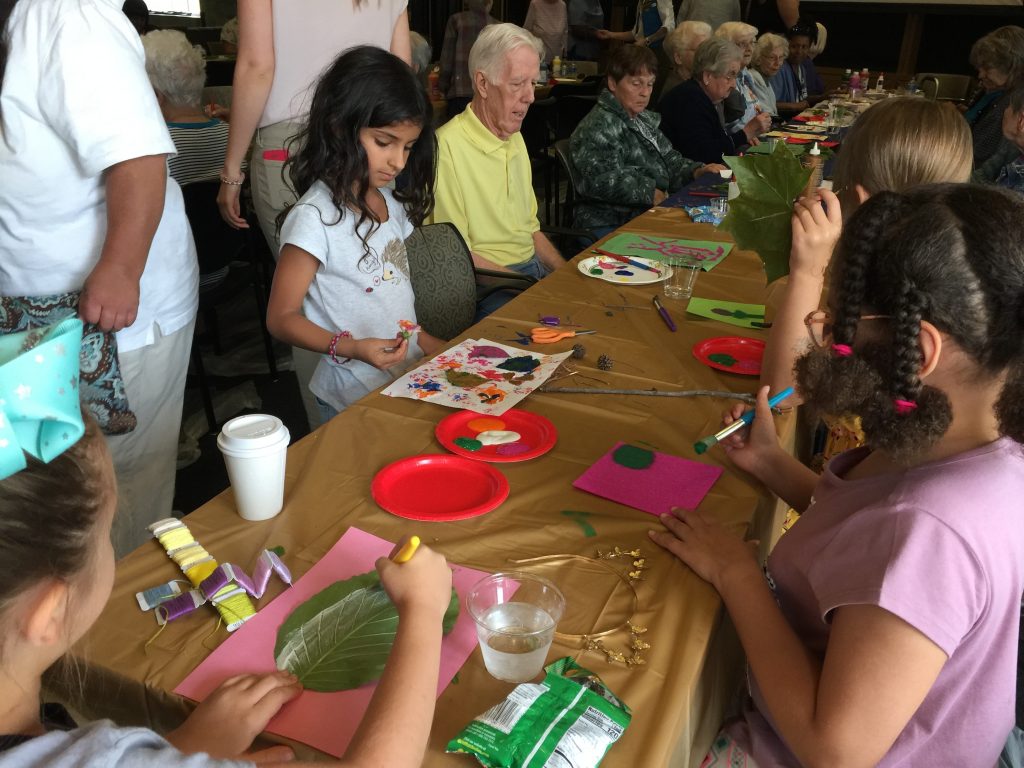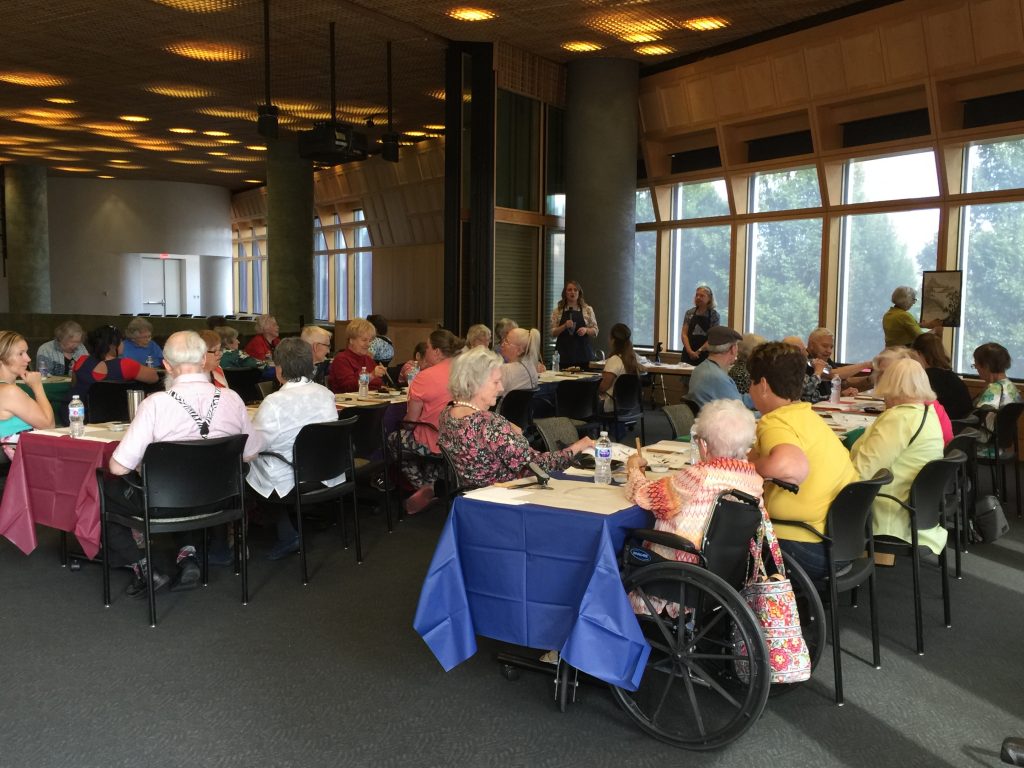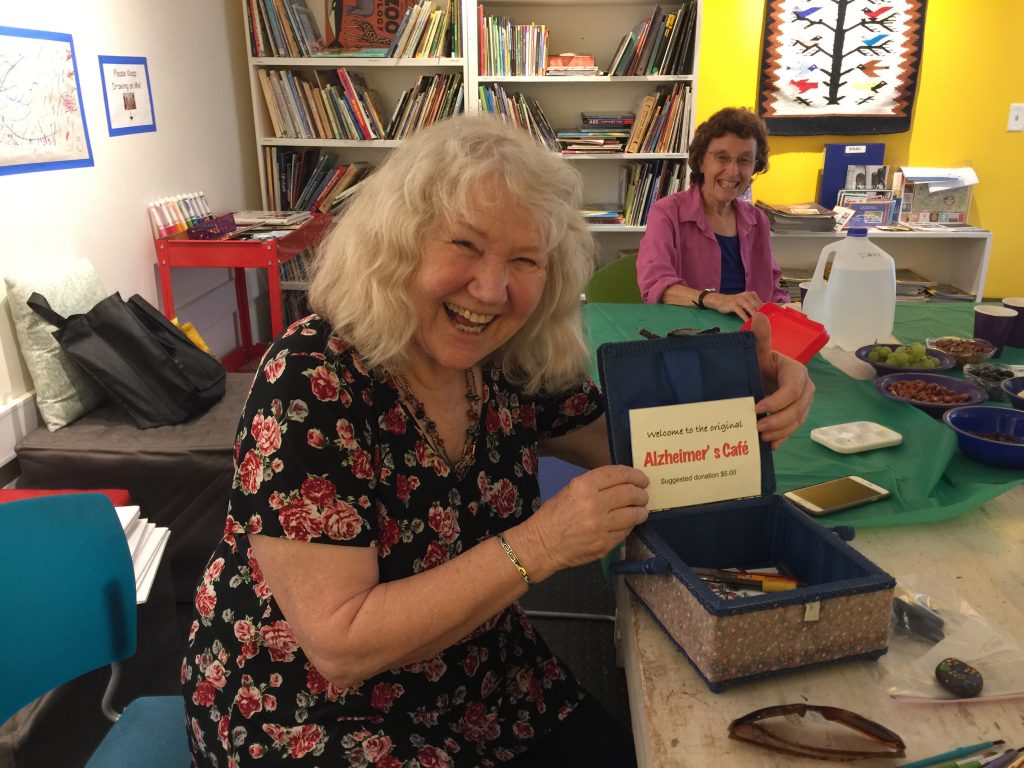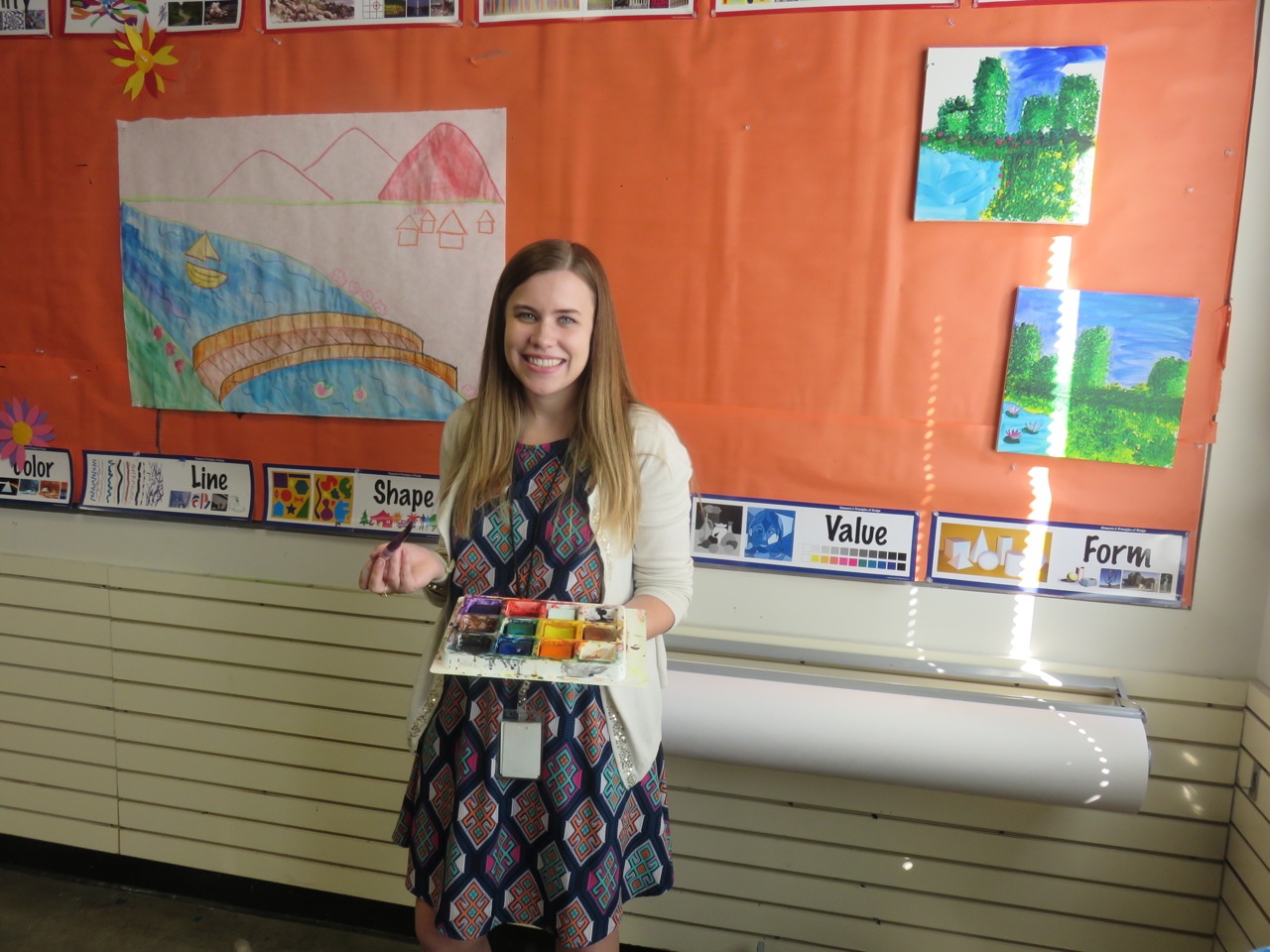Posts Tagged ‘painting’
Using Nature to Connect with Creativity and Generations: KC Memory Cafe
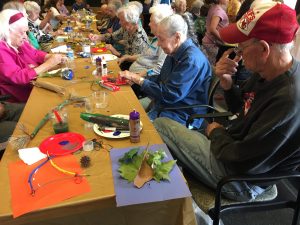 The tables are scattered with pine cones, sycamore leaves, and decorative branches, along with bottles of glue, vivid construction paper, and pots of colorful paint. Our KC Memory Cafe begins with sharing memories of camping, scouting, or outdoor activities. Then a lively group of Girl Scouts leads us in song, reminding us to, “Make new friends, But keep the old, One is silver, And the other gold.”
The tables are scattered with pine cones, sycamore leaves, and decorative branches, along with bottles of glue, vivid construction paper, and pots of colorful paint. Our KC Memory Cafe begins with sharing memories of camping, scouting, or outdoor activities. Then a lively group of Girl Scouts leads us in song, reminding us to, “Make new friends, But keep the old, One is silver, And the other gold.”
After our singalong, cafe guests experiment with the art supplies and natural 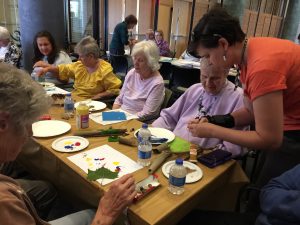 objects. They dip pine cones into red paint and brush blue across crusty leaves. They paint a stick bright orange and wrap it with yarn. The Girl Scouts weave through the artists, pouring extra paint, distributing additional papers, and assisting when asked. The guests work, admire, chat, and laugh as these creative projects emerge. By the end of the cafe, the tables are covered with innovative art and people are smiling as they return home.
objects. They dip pine cones into red paint and brush blue across crusty leaves. They paint a stick bright orange and wrap it with yarn. The Girl Scouts weave through the artists, pouring extra paint, distributing additional papers, and assisting when asked. The guests work, admire, chat, and laugh as these creative projects emerge. By the end of the cafe, the tables are covered with innovative art and people are smiling as they return home.
Click here for a look at our cafe.
Want to introduce more nature into your lives?
 “Research shows that nature-based activity is therapeutic and is essentially a form of treatment for dementia symptoms, helping a person remain at home longer,” says Garuth Chalfont PhD, American Society of Landscape Architects, and author of the. Dementia Green Care Handbook.
“Research shows that nature-based activity is therapeutic and is essentially a form of treatment for dementia symptoms, helping a person remain at home longer,” says Garuth Chalfont PhD, American Society of Landscape Architects, and author of the. Dementia Green Care Handbook.
Gathering flowers, walking a tree-lined sidewalk, plucking a cherry tomato off its vine, watering a house plant, gazing out the window at chickadees—these meaningful natural activities increase pleasure, relaxation, social interactions, and sensory stimulation.
Here are a few other ideas:
• Create observation spots in your living space so you can enjoy looking outdoors. Even watching the weather helps people feel engaged in the natural environment.
• Improve your view with interesting additions, such as bird feeders and birdhouses, bubbling fountains, wind chimes, wind spinners, outdoor sculpture, and various plants and herbs.
• Add resilient plants to your home. 
• Bring in natural objects to touch, identify, arrange, draw and craft with.
• Visit garden centers, parks, playgrounds, and zoos for a rich natural experience.
• Increase your popularity by taking a dog with you on a walk, either your own or borrow your neighbor’s pup.
Click to view informative and inspiring short videos on our YouTube channel
Deborah Shouse is the author of Connecting in the Land of Dementia: Creative Activities to Explore Together and Love in the Land of Dementia: Finding Hope in the Caregiver’s Journey.
Dementia Arts to Draw us Together
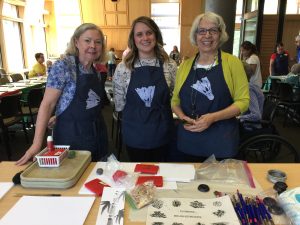 September’s Memory Cafe featured a lively team of educators from the Nelson-Atkins Museum of Art. Using the arts to draw us together, they showed us the Chinese art form of painting pictures of bamboo. About fifty of us gathered in the the library’s spacious lower level. Colorful plastic cloths covered our tables, making it easy to distinguish our drawing paper and painting supplies.
September’s Memory Cafe featured a lively team of educators from the Nelson-Atkins Museum of Art. Using the arts to draw us together, they showed us the Chinese art form of painting pictures of bamboo. About fifty of us gathered in the the library’s spacious lower level. Colorful plastic cloths covered our tables, making it easy to distinguish our drawing paper and painting supplies. 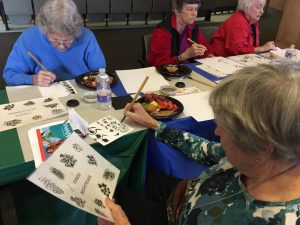 All of us eagerly dipped our special bamboo brushes into the ebony paint and made short pushing movements, replicating segments of the plant’s stalk. Then our educators showed us drawings of bamboo foliage and we experimented with wispy thin lines of leaves.
All of us eagerly dipped our special bamboo brushes into the ebony paint and made short pushing movements, replicating segments of the plant’s stalk. Then our educators showed us drawings of bamboo foliage and we experimented with wispy thin lines of leaves.
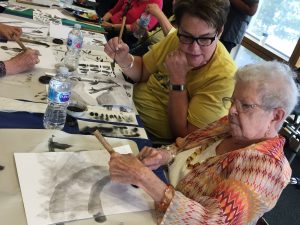 Our common ground continued as our teacher said, “Now, we’re going to pass out large sheets of paper.” We all oohed and aahed and let our strokes grow larger and more confident. At the end, each person created a design in a small wedge of clay, pressed the clay into a red stamp pad, and adorned the painting with our own personal “signature.”
Our common ground continued as our teacher said, “Now, we’re going to pass out large sheets of paper.” We all oohed and aahed and let our strokes grow larger and more confident. At the end, each person created a design in a small wedge of clay, pressed the clay into a red stamp pad, and adorned the painting with our own personal “signature.”• To add extra meaning, connect the artistic activity with something in your partner’s past.
• Invite an intergenerational mixture of artists, from children, grandchildren, art students, and volunteers to join your partner and add encouragement. 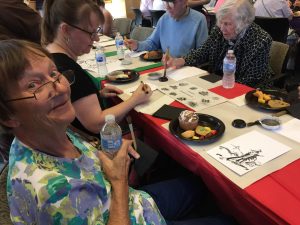
• Create a variety of art-related activities, including visiting galleries or looking at pictures from magazines, as well as painting, drawing or various media.
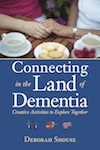
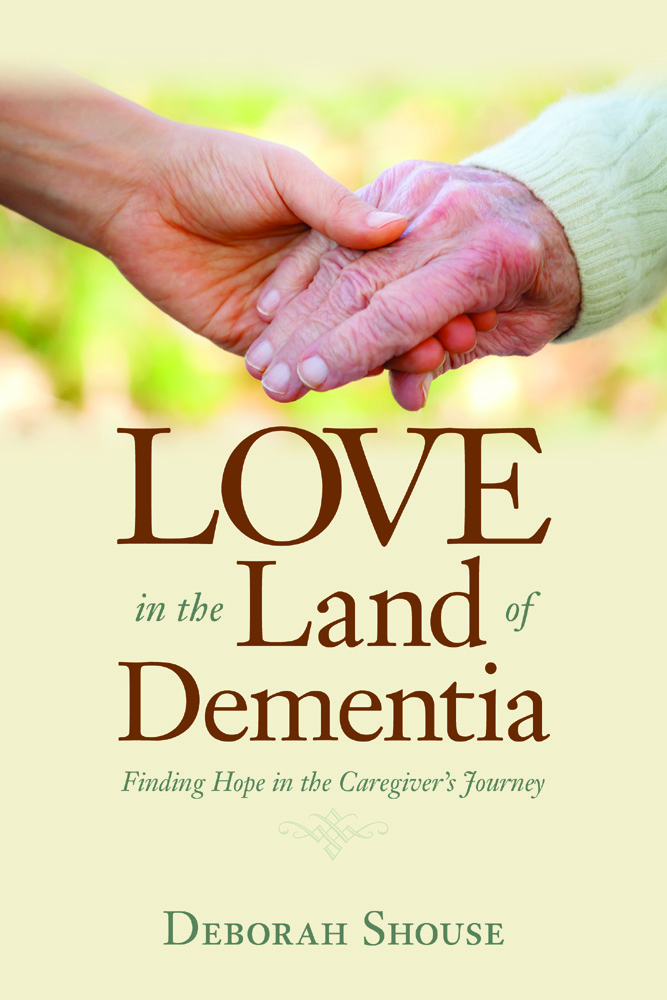
Dementia Friendly Cafes: Inviting Creativity and Connection
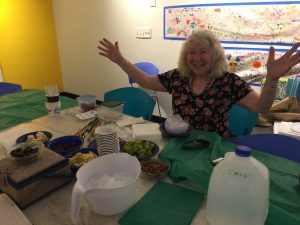 More than 10 years ago, Jytte Lokvig, PhD, was scanning the internet for additional information about dementia. On one of her Google searches she saw the words “Alzheimer’s Cafe” posted by Dr. Bere Miesen, who founded the first Alzheimer’s cafe in Leiden, the Netherlands in 1997. That phrase electrified her. She leapt out of her chair, much to the dismay of her cat, who was cozily sleeping across her feet, and declared, “I am going to make that happen in the U.S.!” She’d been working with people who were living with dementia in community settings for some years, orchestrating art, music, craft and other meaningful projects. But she felt something was missing. That something, she realized, was engagement in the community.
More than 10 years ago, Jytte Lokvig, PhD, was scanning the internet for additional information about dementia. On one of her Google searches she saw the words “Alzheimer’s Cafe” posted by Dr. Bere Miesen, who founded the first Alzheimer’s cafe in Leiden, the Netherlands in 1997. That phrase electrified her. She leapt out of her chair, much to the dismay of her cat, who was cozily sleeping across her feet, and declared, “I am going to make that happen in the U.S.!” She’d been working with people who were living with dementia in community settings for some years, orchestrating art, music, craft and other meaningful projects. But she felt something was missing. That something, she realized, was engagement in the community.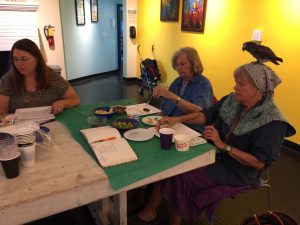 From that inspiration, Jytte created the original U.S. Alzheimer’s Cafe in Santa Fe, NM in 2008. Ten years later, there are more than 300 cafes in the US that invite creativity and connection through dementia friendly cafes.
From that inspiration, Jytte created the original U.S. Alzheimer’s Cafe in Santa Fe, NM in 2008. Ten years later, there are more than 300 cafes in the US that invite creativity and connection through dementia friendly cafes. 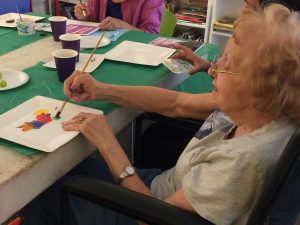 “Would you like a round plate of a square one?” she asked.
“Would you like a round plate of a square one?” she asked.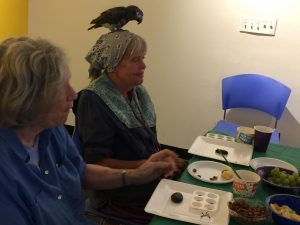
- Arrange a few snacks.
- Invite a guest or two, if you wish. This is an intergenerational project.
- Put a brightly colored plastic covering on the table.
- Squeeze some acrylic paint into a palette. Or use tempura or water colors.
- Offer a choice between two brushes.
- Offer a choice between two canvases: a cardboard paper plate, a river rock, paper, or other.
- Relax and let the painting unfold.
- If your loved ones need a little help, you can paint together. Or you can rest their hand on yours, while you paint to get them used to the movement of the brush.
- Appreciate the art by commenting on the color, the design, the shapes. Don’t ask them to identify the art: enjoy it as it is.
- Weave conversation into your time together.
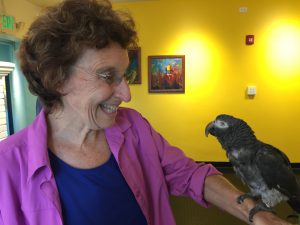
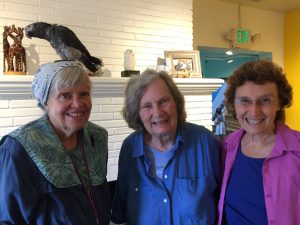
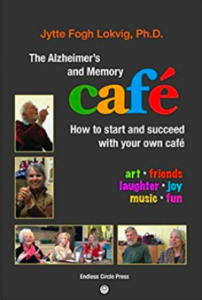


Tips from a Parisian Artist
 There’s something magical about visiting an artist in his studio. Especially if that studio is in Paris. We were honored to meet Patrick Laurin, artist and art therapist, on a recent trip to France.
There’s something magical about visiting an artist in his studio. Especially if that studio is in Paris. We were honored to meet Patrick Laurin, artist and art therapist, on a recent trip to France.
In the beginning, Patrick Laurin’s work with people who were living with dementia went slowly. When he first visited the care home and invited people to join him for painting, he heard various reasons the idea wouldn’t work. “I can’t hear you.” “I can’t see you.” “I can’t move my arm.”
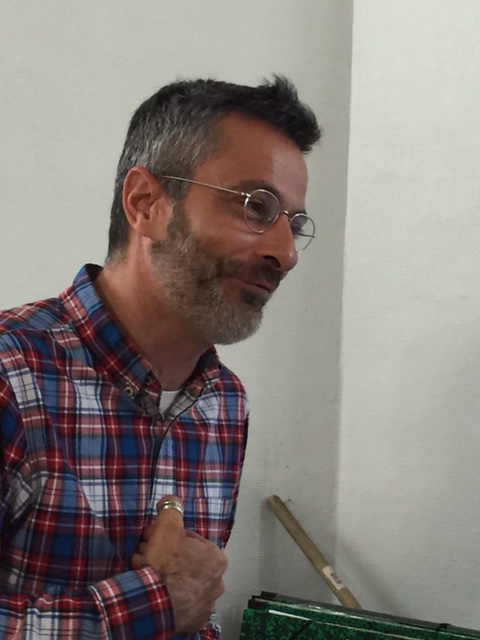 Patrick, who had quit working as researcher in the pharmaceutical industry so he could create deeper connections with clients, understood the importance of building relationships. Gradually, he got to know the people who lived in the community. He wanted to tailor an artistic experience specific to each person’s abilities and needs.
Patrick, who had quit working as researcher in the pharmaceutical industry so he could create deeper connections with clients, understood the importance of building relationships. Gradually, he got to know the people who lived in the community. He wanted to tailor an artistic experience specific to each person’s abilities and needs.
Over time, the people who couldn’t see, hear, or move were all happily involved in painting.
One woman seemed to blossom when holding the brush and stroking on the paint. Even though she couldn’t later remember to say, “I’ve been painting,” she enjoyed the experience.
One day, Patrick was on another floor in the care community when he encountered this woman and her daughter.
Her daughter said to Patrick,” You are the painter.”
Patrick was thrilled her mother had been able to mention the art therapy sessions. But before he could respond, the mother said, “No, the painter is me.”
“Inside, she was seeing herself as an artist,” Patrick says. “The painting strengthened her identity.”
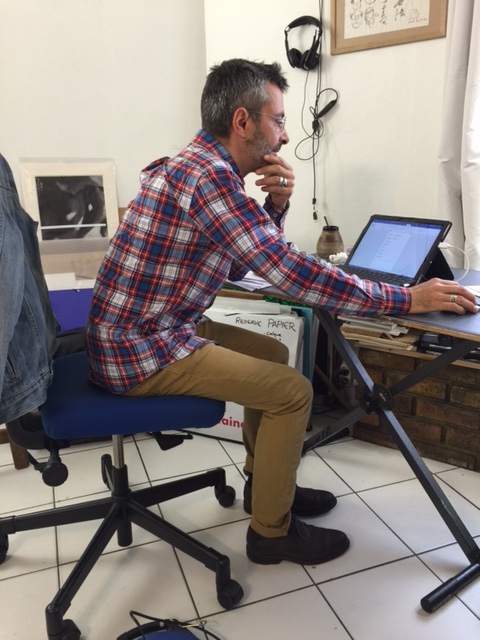 Patrick has learned to approach each person with flexibility. Sometimes Patrick jump starts his artists with a squiggle of color on the page. Then he steps back to let them respond with their own squiggle. If they’re stymied, he offers a choice of two colors.
Patrick has learned to approach each person with flexibility. Sometimes Patrick jump starts his artists with a squiggle of color on the page. Then he steps back to let them respond with their own squiggle. If they’re stymied, he offers a choice of two colors.
He also uses collage techniques to inspire his artists. He selects three separate pictures, each with one recognizable thing, such as a house, tree, or dog. He shows the photos to the artist, and asks, “Which one of these attracts you?” When the artist chooses a photo, Patrick then asks, “Where would you like to put this on the paper?” He and the artist apply paste to the paper.
“We don’t turn over the picture and apply paste, because the image then disappears and that can be confusing,” he says.
When the picture is glued to the paper, Patrick discusses a color that’s already in the picture.
“You could take the blue in the sky and extend it,” he might suggest. This suggestion often inspires the artists to start painting. If they get stuck, Patrick says, “What might look good near the house?” In this way, the painting expands.
For one woman, painting began as a series of colors and grew into a personal story.
She pasted a house and began expanding the lawn. Then she drew a bridge and weeks later, she added in a dog. At first, she was painting “a house, a bridge and a dog.” As the picture took shape, she said, “This is my house and my dog and this is the bridge we had to cross to get to the house.” The process of painting had loosened memories of her childhood home.
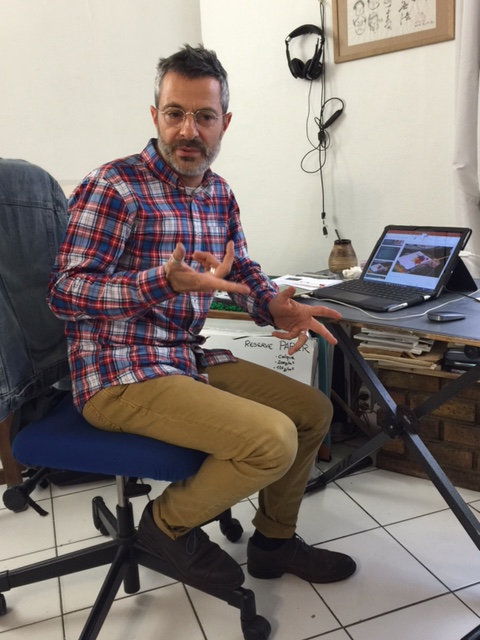 “When I share a piece of art by one of my students, I also share the story behind it,” Patrick says. “The act of creation is more important than the results.”
“When I share a piece of art by one of my students, I also share the story behind it,” Patrick says. “The act of creation is more important than the results.”
Tips:
Pick something that is easy for you, the care partner.
Put a point of color on the pages, then stand back. Offer support but don’t paint.
Enjoy the process and don’t get stuck on the results.
Thanks to Berna Huebner, founder of the Hilgos Foundation and co-producer of the documentary, “I Remember Better When I Paint,” for suggesting we meet with Patrick.
Using Alzheimer’s Art to Lift the Heart
Art enables us to find ourselves and lose ourselves at the same time. Thomas Merton
“Alzheimer’s is scary and art isn’t,” says Marilyn Raichle of Seattle, WA.
Marilyn’s mother Jean discovered her inner artist when she was a mere 89-years-old. Jean had never painted before: when she was growing up on a farm, art was considered childish and frivolous.
Initially, when Jean developed memory problems, she didn’t turn to art. But after Jean’s beloved husband died, Marilyn took her mom to a painting class sponsored by Elderwise, a Seattle-based non-profit that focuses on creative and spirit-centered care.
At first, Jean thought the idea was stupid. But Marilyn noticed how happy her mom was after art class. And Jean’s paintings were good. To honor her mom, Marilyn put together a calendar featuring Jean’s work. So many people commented on the delightful, whimsical quality that Marilyn knew her mother possessed a special talent. She began printing greeting cards graced with her mom’s paintings. She uses the cards to raise awareness for Alzheimer’s.
“Art is a creative way to get people to think about Alzheimer’s,” Marilyn believes. “While the prevailing narrative about dementia tends to focus on sorrow, pain, and loss, my mother’s art tells a different story. One look at her paintings and you see a mind at work, inhabiting a life of creativity, purpose, and joy.”
The Art of the Artist with Alzheimer’s
“Mom is the happiest woman I know,” Marilyn says.
Her mother has been distilled to her essence and Marilyn enjoys being with her.
“Through this dementia journey, my mom has taught me to be patient,” Marilyn says. “She’s changed how I feel about Alzheimer’s and she’s allowed me to relax and not take things so seriously. Mom is teaching me about taking joy in life.”
Marilyn wants to make the Alzheimer’s conversation life affirming, to inspire people to think creatively about senior care.
Meanwhile, though Marilyn’s had a vibrant career working in the arts and organizing arts festivals, she describes herself as a “terrible painter.” She hopes to relax enough to be able to paint with her mom.
Her mom may be an excellent artist, but she is a humble woman. When Jean is praised for her artwork, she laughs and says, “I must have gotten this talent from your father’s side of the family.”
The purpose of art is washing the dust of daily life off our souls. Pablo Picasso
Visit Marilyn’s blog: www.theartofalzheimers.net
Deborah Shouse is the author of Love in the Land of Dementia: Finding Hope in the Caregiver’s Journey.
Focusing on Art and Drawing on Memory
“What art offers is space – a certain breathing room for the spirit.” ~John Updike
“I want us to explore this work of art together,” Laura Voth says, as she passes out small copies of the Leon Kroll painting Lower New York, The Bridge in Winter, 1915. 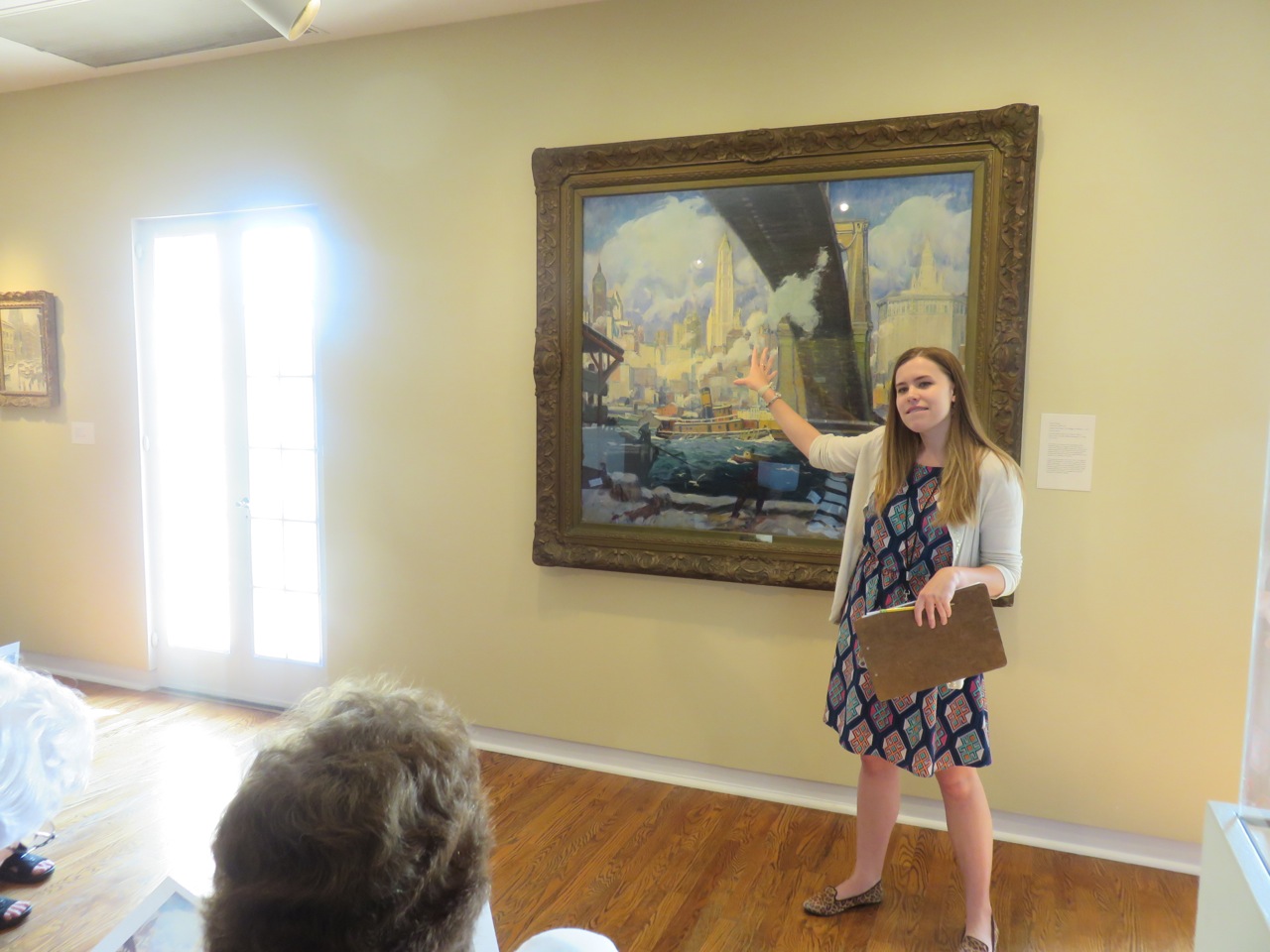
Ron and I have joined today’s session of the Focus on Art program at the Philbrook Museum of Art in Tulsa, Oklahoma. This collaboration between the Museum and the Alzheimer’s Association, Oklahoma Chapter, is part of the Association’s Drawing on Memory program and is designed for people living with dementia and their care partners.
“We’ve been hosting the program for three years and we keep learning from it,” says Jessimi Jones, Philbrook Director of Education. “We’re trying to connect people with art using their imagination and observational skills.”
“We’re also trying to engage people in conversation,” says LaShondia Horn, Early Stage Coordinator with the Association. “Looking at the art together and later creating art stimulates memories.”
Laura Voth, education assistant at the Philbrook, orchestrates the conversation and the drawing session that follows. To engage her audience, she looks for large paintings with recognizable images. Today’s oil features an old-fashioned Manhattan skyline as seen from underneath a bridge. Several boats navigate a choppy river.
Laura offers a little background on the painting, then says, “Take a look at the painting. What do you see?”
“Lots of big buildings,” Thomas says.
“What can you tell me about those buildings?” Laura asks.
“Tall,” Thomas replies.
“It looks like New York but I’ve never seen it from this angle,” Julie says.
I realize I also have never seen New York from that angle and I start noticing a few more of the picture’s details: two tugs boats, bouncing around in the rough waves, several men hoisting a rope from a dock.
“Has anyone else been to New York?” Laura asks.
“We marched through there and got right on a boat,” Thomas says. He’s got a good-natured slouch and a ready smile.
“What would it be like on that boat?” Laura asks.
“I can’t swim,” Julie says.
“I’ve been to New York as a visitor,” Mary says.
“What would you title this painting?” Laura asks.
“Under the Bridge,” Mary says.
The conversation continues as Laura asks sensory and observational questions about the picture? What time of year do you think it is? Does the painting make you feel small or tall? What do you think that round building is? What would you put in that round building?
Every one is participating, gazing at the river, the buildings, treating each question with curiosity.
After the conversations, we go downstairs to create our own art.
In the art room, each person has a large sheet of drawing paper, which is easy to see against the dark green paper that covers the table. LaShonda and her team work with the museum staff making sure each person is comfortable and can reach the art supplies. As Laura guides us through drawing simple lines to create a bridge, the conversation continues. Click here for a one-minute tutorial from Laura on using paints and oil pastels.
I’m sitting across from Emily, who says, “I can’t draw.”
I ask what color she likes and she says, “Purple.”
I show her the purple paint and ask if she’d like to try some.
She dips in her brush and strokes paint across the paper.
Color by color, she asks, “What now? What color shall I use? Where does this color go?”
During our painting session, I learn she was born in West Virginia, she doesn’t like to cook, she has five children and her brother is a wood carver. One of her treasured possessions is a carving of Dopey that her brother created when he was a teenager.
At the end, Emily has a wonderfully vibrant painting to take home and I have the wonderfully vibrant feeling of having connected with a fascinating woman.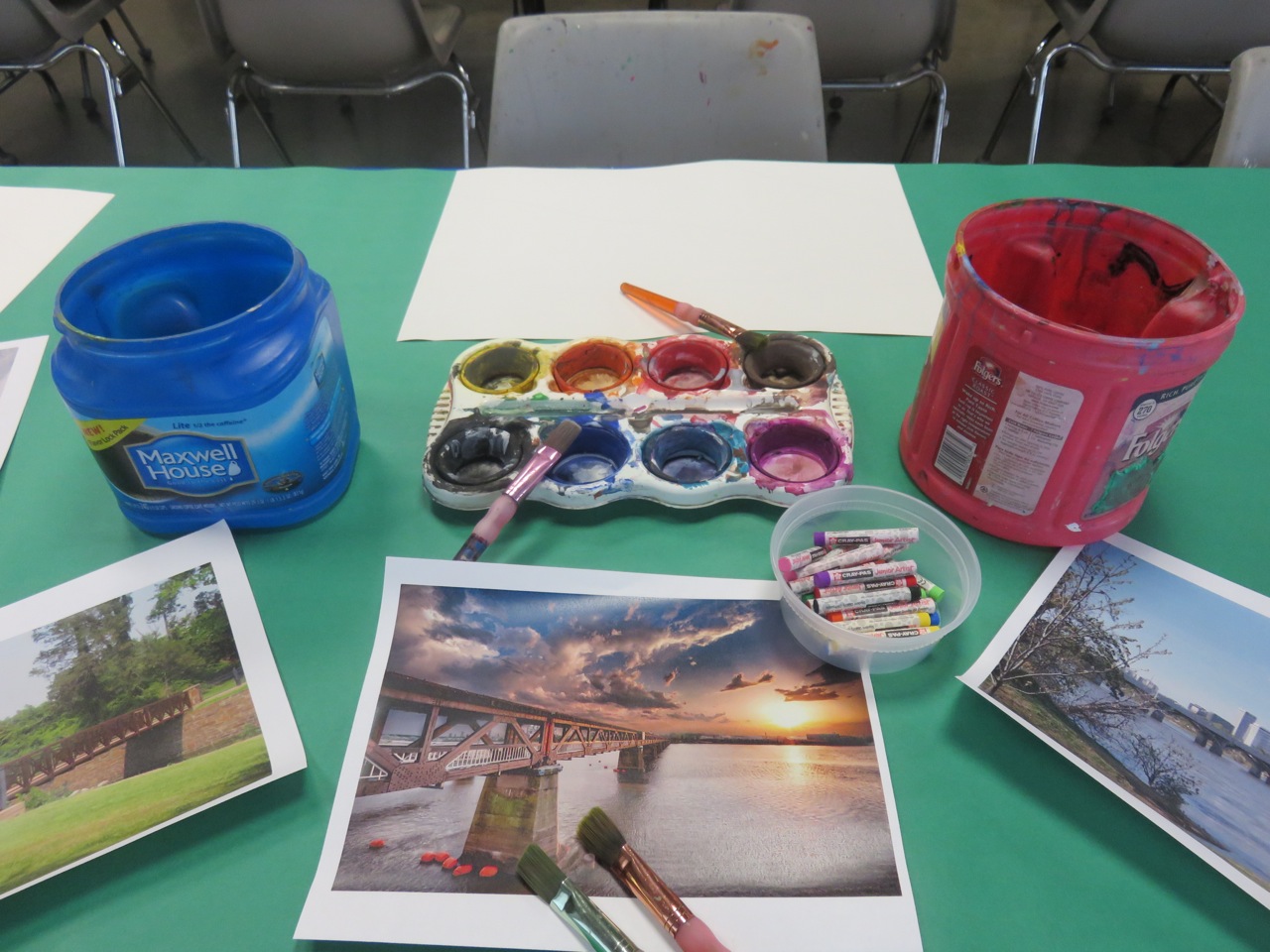
For more information about the Philbrook, go to www.philbrook.org
The Alzheimer’s Association Website is www.alz.org/
Deborah Shouse is the author of Love in the Land of Dementia: Finding Hope in the Caregiver’s Journey.
